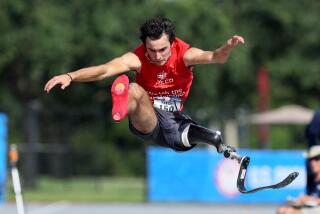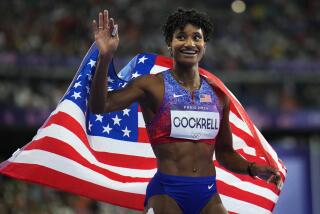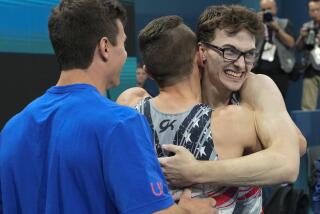After Breaking Wrists, He Didnât Break Stride : Ex-Vaulter Powell Goes For State Title in 110 High Hurdles
If not for two injury-prone wrists, Drue Powell of Reseda High might not have become one of the top hurdlers in the state.
Powell will be one of the favorites in the boysâ 110-meter high hurdles in todayâs state track and field championships at Cerritos College. Yet he began his career at Reseda as a pole vaulter who dabbled in the sprints and long jump. He switched to the hurdles midway through his freshman season because he suffered a severely sprained right wrist while vaulting.
âI couldnât vault with my hand and wrist all wrapped up,â Powell said. âBut I could still run so I asked (Reseda Coach Steve Caminiti) if I could give the hurdles a try.â
Caminiti, who finished third in the 120-yard high hurdles in the 1964 state meet as a Crespi High senior, would like to say that he knew Powell had the talent to win consecutive City Section titles as a junior and senior, and place third in the state last year, but that was not the case.
âInitially, I thought he would be OK,â Caminiti said. âBut I never thought, âThis kid is going to be a great hurdler.â But once he got going into it, you could tell he had a lot of potential.â
Powell wasnât so sure. In the beginning, he considered it a major accomplishment when he finished a race upright--without any major cuts or contusions.
âWhen you first start running the highs, itâs like, âWow, I made it over one,â â Powell said. âThatâs all it is. Itâs like, âWow, Iâm not lying on the ground. So let me go on to this next one.â â
Caminiti, known as the âCrespi Cometâ during his glory days, saw similarities between himself and his protege.
Like Caminiti, the 5-foot-9, 146-pound Powell is small in stature compared to most top high hurdlers, but what he lacks in height, he makes up for in technique and desire.
âMentally, heâs a pretty tough kid,â Caminiti said. âHeâs always ready to compete. If someone beats Drue, itâs usually because the guy was a superior athlete, not because Drue made a mistake.â
Powell doesnât fret over the size of his fellow competitors, but that wasnât always the case.
During the first half of his sophomore season, Powell frequently found himself conceding races to hurdlers who were bigger and taller.
âI would sit there in the blocks and look around and think, âI canât beat this guy, heâs too tall,â â Powell said. âBut then Cam talked to me one day and said, âDonât worry about it. You have less room for error than other hurdlers because of your size, but that doesnât mean you canât beat them. You just have to be better technically than they are.â â
With that thought in mind, Powell won the C division of the 300 intermediate hurdles in the 1991 City championships and finished fourth in the 110 highs in the intermediate (ages 15 and 16) division of the Junior Olympic championships in North Carolina that summer.
He continued to make strides as a junior, but no one expected him to defeat defending champion Raymond Banner of Birmingham for the City title.
âI thought I could give him a good race,â Powell said. âBut I wasnât like, âOh, Iâm going to win.â I remember watching Banner win the City championships (in 1991) and thinking, âWow. He was moving .â The hurdles werenât even slowing him down.â
Powell, who is being recruited by UCLA, USC, North Carolina and Cal State Northridge, began his senior campaign in impressive fashion. He won the 50-meter highs in the Sunkist Invitational at the Sports Arena in February, but a groin injury slowed him from the middle of March until early April.
He was fourth in the Northridge Invitational on March 13, and after taking time off to heal, he ran third in the seeded race of the Arcadia Invitational on April 10.
Powell, an only child, credits his mother Almeta with maintaining his spirits during that period.
âMy Mom is a role model to me in a never-quit type of way,â Powell said. âShe has always told me to never quit. To never let obstacles that get in your way prevent you from reaching your goal.â
Those words prophetic for her son, whose goal in the highs is to get from point A (the starting line) to point B (the finish) as fast as possible while clearing 10 hurdles, which stand 3 feet 3 inches.
âI never really knew he could run,â Almeta said. âThe first time I saw him run, I said, âDrue, you never told me you could do this.â He just kind of smiled and shrugged his shoulders.â
Almeta, who has raised Drue by herself since she and his father divorced when he was 2, admits that her son showed signs of being a hurdler at a young age. She often would return home and notice that the furniture had been rearranged, but she didnât realize until later that Drue had been running over, around and sometimes into the makeshift obstacles.
âI remember coming home one day and noticing that the glass-top coffee table no longer had any glass,â Almeta said with a laugh. âI asked Drue what happened and he said, âI kind of missed.â â
That was not the first or the last time that Powell would take an unexpected fall. Seven broken wrists attest to that.
âI donât know what it is, but my wrists just break very easily,â he said. âI remember one year when I was in elementary school that I jumped off a swing and broke my right wrist. A couple of months later, I did the same thing and broke my left wrist. After that I figured out that Iâd better not jump off swings any more.â
Although Powell has always been brimming with energy, he is not a hyperactive kid with a short attention span.
Indeed, Caminiti says that Powellâs greatest assets as a hurdler are his ability to listen and to stay focused during a race.
âYou can explain something to him and he understands the concept very well,â Caminiti said. âYou usually donât have to tell him or show him something twice. . . . In a race heâs almost like a racehorse with blinders on. He just gets so tuned in to what heâs doing.â
Four thoughts go through his mind repeatedly during the course of a 14-second race, Powell said.
âI worry about staying on my toes,â he said. âI worry about keeping my knees high. I worry about good lean, and good arm action. All the right things that we talk about in practice.â
Caminiti has refined Powellâs technique over the past four years, and those sessions have also formed a bond between the two.
âCam is like the father figure I didnât have,â Powell said. âI have my Mom to lead me in the right direction, but I also have Cam.â
Powell, who has not seen his father in several years, points out that his mother frequently tells Caminiti to make sure that her son âeats his vegetables, takes his vitamins and keeps out of trouble.â
If Powell runs as well as expected today, he will probably be offered a scholarship to a NCAA Division I school, a fact that still amazes him.
âWhen I started competing in track, I never thought of it as a way to get a college scholarship,â Powell said. âIt was just something I wanted to do because it looked like fun.â
More to Read
Get our high school sports newsletter
Prep Rally is devoted to the SoCal high school sports experience, bringing you scores, stories and a behind-the-scenes look at what makes prep sports so popular.
You may occasionally receive promotional content from the Los Angeles Times.






